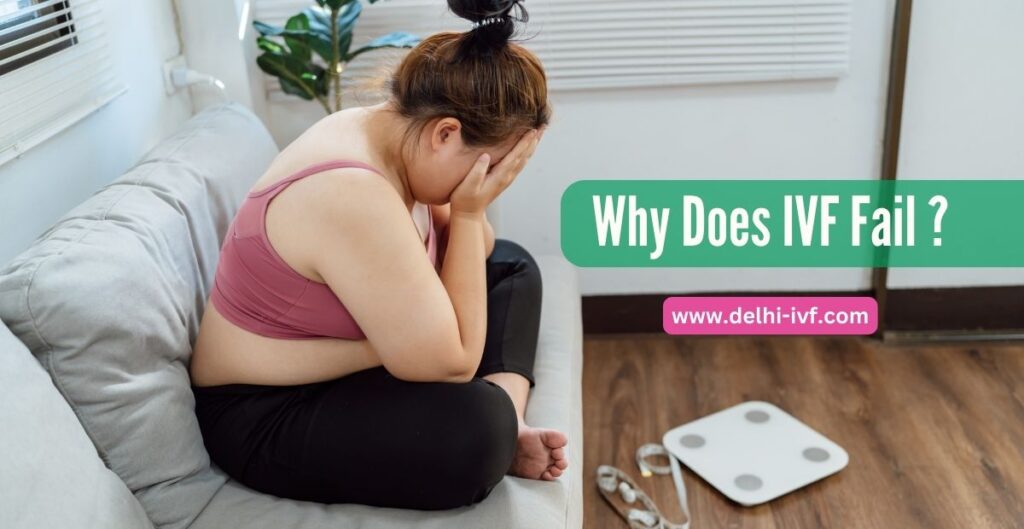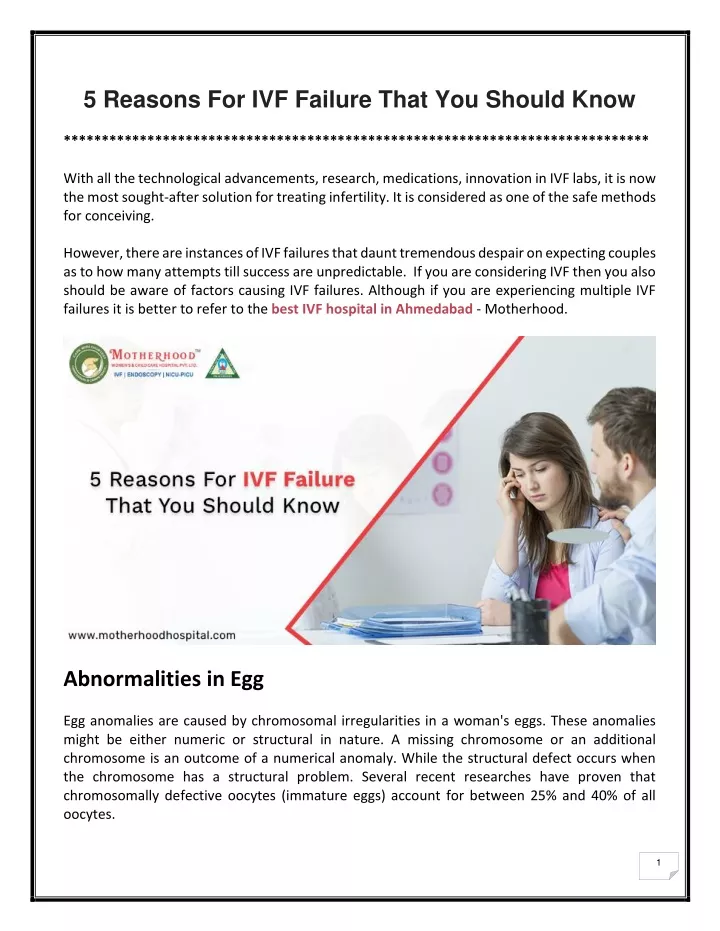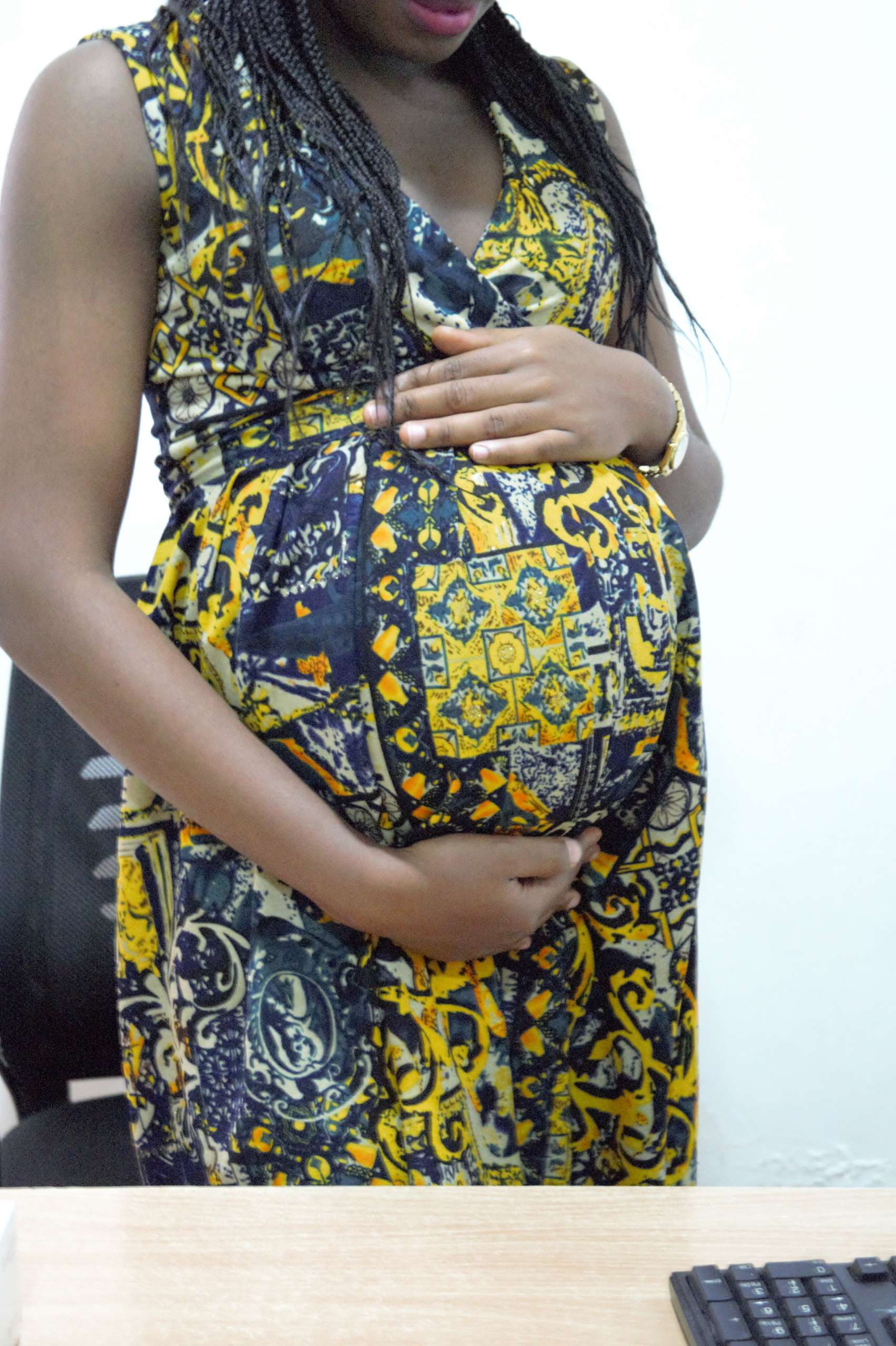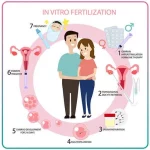Why Does IVF Fail? A Deep Dive into the Challenges and Hope Behind In Vitro Fertilization
In vitro fertilization (IVF) has been a game-changer for millions of people dreaming of starting a family. Since the first IVF baby, Louise Brown, was born in 1978, this technology has brought hope to couples facing infertility. Today, over 8 million babies have been born through IVF worldwide. But despite its incredible promise, IVF doesn’t always work. For every success story, there are families who face disappointment, sometimes after multiple tries. So, why does IVF fail? What’s really going on behind the scenes?
This isn’t just about statistics or science—it’s about understanding the journey, the hurdles, and the possibilities. Whether you’re considering IVF, in the middle of it, or supporting someone who is, knowing why it sometimes doesn’t work can feel empowering. Let’s explore the big reasons, the hidden factors, and what you can do to boost your chances, all while keeping things real and relatable.
The Basics: What Happens During IVF?
Before we dive into why IVF fails, let’s picture what’s happening. IVF is like a carefully choreographed dance. Doctors stimulate a woman’s ovaries to produce multiple eggs, collect those eggs, and combine them with sperm in a lab. The goal? Create healthy embryos that can be placed back into the uterus to grow into a baby. It sounds straightforward, but there are so many steps where things can go off track.
Think of it like baking a cake. You need the right ingredients (eggs and sperm), the perfect recipe (lab conditions), and a good oven (the uterus). If any part of the process isn’t just right, the cake might not rise. IVF is the same way—every stage has to align for success.
The Big Picture: How Often Does IVF Fail?
IVF success rates have come a long way, but they’re still not 100%. According to the CDC, about 50% of IVF cycles for women under 35 result in a live birth. That number drops as age climbs—down to around 20% for women aged 38-40 and even lower after that. So, yes, IVF fails more often than it succeeds for many people, especially as they get older.
But here’s the thing: failure doesn’t mean it’s over. Each cycle teaches doctors and patients something new. The trick is figuring out what’s tripping things up and how to tweak the plan. Let’s break it down into the main culprits and some lesser-known factors that don’t get enough attention.
Embryo Quality: The Heart of the Matter
At the core of IVF is the embryo—the tiny cluster of cells that could become a baby. If the embryo isn’t strong or healthy, the whole process can stall. But what makes an embryo “good” or “bad”?
Chromosomal Abnormalities: A Common Roadblock
One of the biggest reasons IVF fails is that embryos often have the wrong number of chromosomes—either too many or too few. This is called aneuploidy, and it’s more common than you might think. Research from Columbia University shows that most human embryos stop developing within days of fertilization because of these chromosome glitches. It’s not anyone’s fault; it’s just biology doing its thing.
As women age, the chances of these errors go up. For example, a woman in her 20s might have 20-30% of her embryos affected, while for someone over 40, it could be 60-80%. That’s why younger women tend to have higher IVF success rates.
What Science Says
A 2022 study from Columbia found that these chromosome mistakes often happen during the first cell division after fertilization. The DNA copying process hits a snag, and the embryo can’t recover. If too many cells are affected, it stops growing altogether. This explains why even “perfect-looking” embryos under a microscope might not make it.
What You Can Do
- Preimplantation Genetic Testing (PGT): This test checks embryos for chromosome issues before they’re transferred. It’s not foolproof, but it can boost your odds by picking the healthiest ones.
- Lifestyle Boosts: Eating well, cutting stress, and avoiding toxins like smoking might help egg and sperm quality, which could lower the risk of these errors.
Implantation Issues: When the Embryo Won’t Stick
Even if you’ve got a great embryo, it still has to implant in the uterus. This is where things get tricky. Imagine the embryo as a seed and the uterus as soil—if the soil isn’t ready, the seed won’t grow.
Uterine Conditions: The Hidden Culprit
Sometimes, the uterus isn’t in tip-top shape. Things like fibroids (non-cancerous growths), endometriosis (where uterine tissue grows outside the uterus), or a thin uterine lining can make implantation tough. A 2020 Rutgers study found that these issues are linked to repeated IVF failures and miscarriages.
Timing Is Everything
The “window of implantation”—those few days when the uterus is ready—has to match up perfectly with the embryo transfer. If the timing’s off by even a day, the embryo might not stick. Some clinics use an endometrial receptivity analysis (ERA) to pinpoint this window, but it’s not standard everywhere.
Practical Tips
- Check Your Uterus: Ask your doctor for a hysteroscopy or ultrasound to spot any physical issues before starting IVF.
- Support the Lining: Medications like progesterone can thicken the uterine lining, giving the embryo a better shot at implanting.
Egg and Sperm Quality: The Building Blocks
Embryos come from eggs and sperm, so if either isn’t up to par, IVF can hit a wall. This is where age, lifestyle, and even genetics come into play.
Egg Quality and Age
Egg quality declines with age—it’s a fact of life. By 35, eggs start losing their oomph, and after 40, the drop is steep. Older eggs are more likely to have chromosome issues or not develop properly after fertilization. A 2023 study from the National Institutes of Health noted that egg quality is the single biggest factor in IVF success for women over 35.
Sperm Struggles
Sperm isn’t off the hook either. Low count, poor motility (how well they swim), or DNA damage can mess things up. A surprising 2024 finding from the Cleveland Clinic showed that even “normal” sperm samples can carry hidden DNA flaws that hurt embryo development.
Boosting Your Chances
✔️ For Women: Antioxidant-rich foods (think berries and nuts) and supplements like CoQ10 might improve egg health, according to small studies.
✔️ For Men: Cut back on alcohol, quit smoking, and keep things cool down there (no hot tubs!) to protect sperm quality.
❌ Avoid Overdoing It: Too many supplements without a doctor’s okay can backfire—balance is key.
The IVF Process Itself: Where Things Can Go Wrong
IVF isn’t just about biology; it’s also about the lab and the clinic. Mistakes or mismatches here can lead to failure, even with perfect eggs and sperm.
Lab Conditions: Not All Are Equal
The lab where embryos are made matters—a lot. Temperature, air quality, and even the skill of the embryologist can affect outcomes. A 2021 Rockefeller University study suggested that tiny lab errors might explain some “unexplained” IVF failures.
Stimulation Snags
During ovarian stimulation, the goal is to get multiple eggs. But if the dose of fertility drugs is too high, you might get ovarian hyperstimulation syndrome (OHSS), which can derail the cycle. Too low, and you might not get enough eggs. It’s a Goldilocks situation—it has to be just right.
What to Watch For
- Ask Questions: Find out about your clinic’s lab standards and success rates for your age group.
- Monitor Closely: Work with your doctor to adjust meds if your body’s response seems off.
Interactive Check-In: How’s Your IVF Knowledge?
Let’s pause for a quick quiz! Answer these in your head (or jot them down if you’re feeling extra):
- What’s the most common reason embryos don’t make it?
- A) Bad lab conditions
- B) Chromosomal errors
- C) Poor timing
- True or False: Sperm quality doesn’t affect IVF if you’re using ICSI (intracytoplasmic sperm injection).
- What’s one thing you can do to help implantation?
(Answers: 1-B, 2-False, 3-Check uterine health or support the lining.)
How’d you do? This stuff can feel overwhelming, but you’re already getting the hang of it!

Lesser-Known Factors: The Stuff You Don’t Hear About
Now, let’s dig into some reasons that don’t always make the headlines. These are the sneaky factors that might be flying under the radar in your IVF journey.
Stress and the Mind-Body Connection
You’ve probably heard that stress doesn’t help fertility, but did you know it might mess with IVF too? A 2024 study from the American Society for Reproductive Medicine found that women with high cortisol (stress hormone) levels had lower implantation rates. It’s not about “relaxing and it’ll happen”—it’s about how stress might subtly tweak your hormones or immune system.
What You Can Try
- Mini Breaks: Even 10 minutes of deep breathing or a walk can lower cortisol.
- Support Squad: Therapy or a fertility support group can lighten the emotional load.
Immune System Overreactions
Your immune system is supposed to protect you, but sometimes it gets confused. In rare cases, it might see an embryo as a threat and attack it. This idea—called reproductive immunology—is controversial, but a small 2023 study from PMC suggested that immune imbalances could play a role in repeated IVF failures.
A Simple Analogy
Think of your uterus as a bouncer at a club. Normally, it lets the embryo (the VIP) in. But if the bouncer’s too strict (overactive immune system), the VIP gets turned away. Doctors can sometimes use meds like steroids to calm things down, but it’s not a one-size-fits-all fix.
Environmental Toxins: The Silent Saboteur
Ever wonder what’s in the air you breathe or the water you drink? Chemicals like BPA (found in plastics) or pesticides might harm egg and sperm quality. A 2025 report from the Environmental Protection Agency flagged these “endocrine disruptors” as possible fertility foes, yet they’re rarely discussed in IVF prep.
Action Steps
✔️ Go Green: Swap plastic containers for glass and choose organic produce when you can.
❌ Don’t Panic: The risk is small, but every little bit helps.

When It’s “Unexplained”: The Frustration Factor
Sometimes, IVF fails and no one knows why. Everything looks perfect—great embryos, healthy uterus, spot-on timing—but it still doesn’t work. This happens in about 10-15% of cases, and it’s maddening. A 2022 Mayo Clinic review called it “unexplained IVF failure,” and it’s a reminder that science doesn’t have all the answers yet.
A New Angle: Embryo Self-Correction
Here’s a wild twist: some “bad” embryos might not be so bad. A 2021 Rockefeller University study found that embryos with chromosome issues can sometimes fix themselves after implantation. Doctors used to toss these out after genetic testing, but now some are rethinking that. It’s not standard practice yet, but it’s a glimmer of hope for “unexplained” cases.
Coping With the Unknown
- Second Opinions: Another clinic might spot something your team missed.
- Keep Notes: Track your cycles—symptoms, meds, anything—to share with your doctor.
Real Stories: Putting Faces to the Stats
Let’s meet Sarah, a 36-year-old teacher from California. She tried IVF three times. The first cycle gave her five embryos, but none implanted. Her doctor found a small fibroid and removed it. The second cycle failed too—chromosome issues. By the third, she used PGT, picked a healthy embryo, and now she’s mom to a 2-year-old. Sarah’s story shows how failure can lead to answers.
Then there’s Mike and Jen, both 32. Their sperm and eggs were top-notch, but two cycles flopped. A new clinic suggested tweaking the stimulation protocol and checking Jen’s immune markers. Third time was the charm—a baby boy. Their case highlights how persistence and fresh eyes can pay off.
Boosting Your Odds: Practical Steps for Every Stage
IVF isn’t a guarantee, but you’re not powerless. Here’s a step-by-step guide to tilt the scales in your favor, based on the latest research and real-world wisdom.
Step 1: Prep Your Body (3-6 Months Before)
- Nutrition: Load up on folate, omega-3s, and vitamin D. A 2023 NIH study linked these to better egg quality.
- Sleep: Aim for 7-8 hours. Poor sleep messes with hormones, per a 2024 sleep study.
Step 2: Pick the Right Team
- Clinic Stats: Look at live birth rates for your age, not just pregnancy rates.
- Communication: Choose a doctor who listens and explains.
Step 3: During the Cycle
- Stay Flexible: If egg numbers or quality look off, ask about adjusting meds mid-cycle.
- Partner Up: Both of you should optimize health—sperm counts too!
Step 4: After Transfer
- Rest Smart: Light activity is fine; bed rest isn’t proven to help.
- Mindset: Plan a distraction—binge a show or call a friend.
Interactive Poll: What’s Your Biggest IVF Worry?
Take a sec to vote (mentally or in the comments if you’re reading this online):
- A) Embryo quality
- B) Implantation failing
- C) Cost and stress
- D) Something else
What’s on your mind? Knowing what worries others might make you feel less alone—and I’ll bet you’re not the only one picking your answer!

The Cost Factor: A Hidden Reason for “Failure”
IVF isn’t cheap—$12,000 to $25,000 per cycle in the U.S., says a 2025 White House report. For some, “failure” isn’t just biological; it’s financial. If you can only afford one shot, even a small hiccup feels like the end. This isn’t talked about enough, but it’s real.
A Fresh Take: Micro-IVF
Ever heard of micro-IVF? It’s a lighter, cheaper version using fewer drugs. A 2024 PMC study found it works well for younger women with good ovarian reserve, cutting costs by 30-50%. It’s not for everyone, but it’s an option worth asking about.
Looking Ahead: What’s New in IVF?
Science isn’t standing still. Here are three breakthroughs that could change why IVF fails:
- AI-Powered Embryo Selection: Clinics are testing artificial intelligence to pick the best embryos, beyond what human eyes can see. Early results from 2025 trials are promising.
- Mitochondrial Boosts: Adding extra energy (mitochondria) to eggs might help older women, per a 2023 study. It’s experimental but exciting.
- Uterine Microbiome: A 2024 discovery suggests a healthy mix of bacteria in the uterus could improve implantation. Probiotics might play a role soon.

Wrapping Up: Failure Isn’t the End
IVF failing can feel like a punch to the gut, but it’s not a dead end. Whether it’s wonky chromosomes, a tricky uterus, or something we can’t even pin down yet, each cycle is a chance to learn. You’re not just a number—you’re a detective in your own story, working with your team to crack the case.
So, why does IVF fail? It’s a mix of biology, timing, and a dash of mystery. But with every try, you’re gathering clues—about your body, your options, and what might work next. Hang in there. The road’s tough, but the destination could be worth it.


